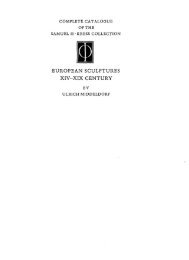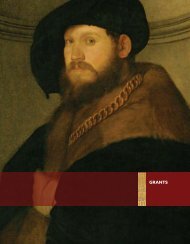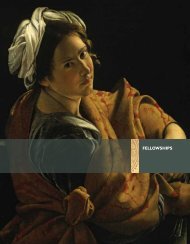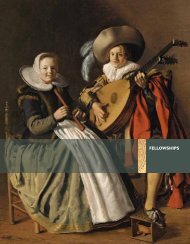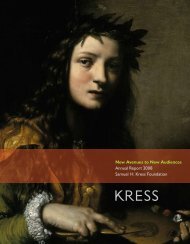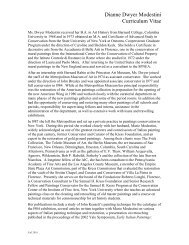The Campus Art Museum - Samuel H. Kress Foundation
The Campus Art Museum - Samuel H. Kress Foundation
The Campus Art Museum - Samuel H. Kress Foundation
Create successful ePaper yourself
Turn your PDF publications into a flip-book with our unique Google optimized e-Paper software.
We’ve got kids from all over campus who normally don’t talk to each other.<br />
We’ve got art history, we’ve got artists, we’ve got business students, we have<br />
architecture students, and we have an economist…. We are focusing on the<br />
contemporary art market… and talk about museums, of course, galleries,<br />
auctions, artists, collectors, dealers, art as an investment, the tax rules related<br />
to art, the nuts and bolts of the business.<br />
By the museum becoming part of their classes, business concepts became real and<br />
more interesting for students.<br />
Interdisciplinary analysis as used here refers to examining a concept or<br />
process through several disciplinary lenses, including an aesthetic one, or at<br />
least, a museology lens. <strong>The</strong> next section on comparative analysis extends this<br />
interdisciplinary approach, but looks at an issue, idea, or process across cultures<br />
and/or over time.<br />
Comparative Analysis<br />
We were talking about Oceania and headhunting rituals and the cannibalism<br />
of eating the body and drinking the blood and the students were saying, “Oh,<br />
this sounds very strange,” and I didn’t say anything because I knew what was<br />
coming. We went down to the paintings of the Eucharist. I said, “I’m a Catholic<br />
and we talk about transubstantiation and it literally changes to the body and<br />
blood of Christ”…. Another favorite tour is Food for Thought…. Students got very<br />
interested in this idea of ingesting food and changing consciousness because<br />
that came up whether it was hallucinogens in ancient America or Kava in<br />
Oceania or whether it was the Eucharist…. That kept coming up as a sub-theme<br />
and the instructor said, “Can we just make a tour on this?” And I said, “We can<br />
do anything.” I love a challenge. We did a tour on bovines, looking at bovines<br />
in the collection because they were reading about bovines in anthropology. We<br />
looked at images of bovines throughout civilizations and throughout history.<br />
We looked at them as beasts of burden, or sacrificial animals and we got into<br />
some really interesting conversations. (curator of education)<br />
<strong>The</strong> art museum lends itself well to comparing concepts over time and/or across<br />
cultures. A professor and curator/educator generally work together to create the class or<br />
classes. As a result of discussions with museum staff, a biology professor now takes his<br />
students to the museum to comparatively analyze expressions of love across cultures:<br />
It’s evolved over the years, but the basic focus one could say would be looking<br />
at the representation of love in artwork. It arose from our studies in biology<br />
class in which we see the manifestation of depressive illness varies particularly<br />
from East and West because of the mind/body split in the West and its<br />
supposed absence from the East. So that in the West a person feeling depressed<br />
might speak of feeling blue, feeling isolated—it’s very feelings, whereas in the<br />
East no regard to feeling, but it would be upset stomach, belching, diarrhea. It’s<br />
a very visceral manifestation…. It gets attributed to the mind/body split. So we<br />
asked in class if such a dichotomy can be seen within depressive illness, can it<br />
Meeting Course Objectives through the <strong>Art</strong> <strong>Museum</strong><br />
15



